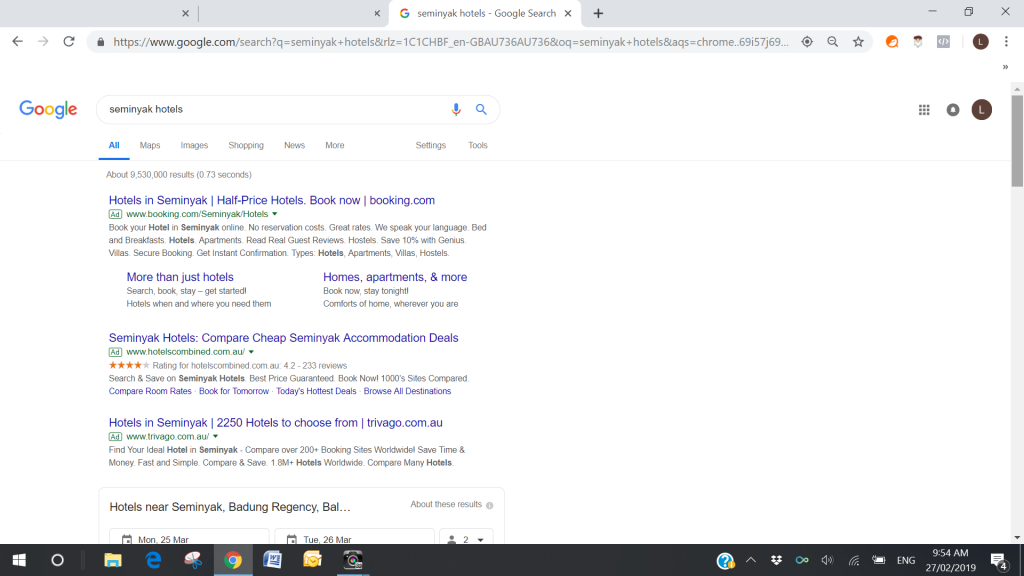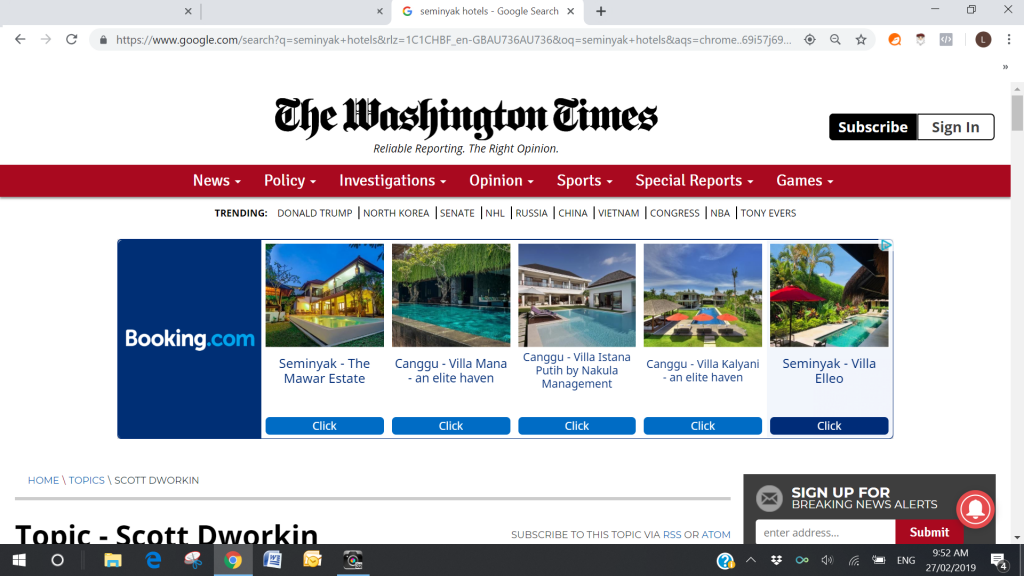Google Search versus Google Display
Clients often ask me about the differences between Google Search and Google Display Advertising in their Adwords accounts. Most are not really aware of the key differences between the two main modes of PPC (Pay Per Click) advertising so I thought I might tackle it here.
So what does Google Search mean in my Adwords account?
Google Search is the most common way for businesses to get involved in Adwords. Bids are placed for specific keywords that relate to or are relevant to a business’ products or services. On the search network, ads are displayed either at the top or bottom of the SERP (Search Engine Results Page). Obviously the higher the position on the first page of the SERP, the higher the cost of the bid.
Here’s an example of how a typical ad may be displayed on the search network. In this case, I searched for hotels in Seminyak. It’s a pretty specific product to be searching for and the result returned at the top of the SERP would certainly have me clicking through to the site.

In the case above you can see that the Search Network is very focused on delivering a result to consumers that is relevant to the product or service they are searching for. Think of it as matching buyers and sellers.
So how would this look as a Display Ad?
The result would look vastly different as a Display Ad , however it’s not returned on the SERP, rather it’s returned somewhere on the Display Network after I have carried out my initial search and visited the Booking.com site. In this case there’s been some clever remarketing employed by Booking.com who would have various display ads in various configurations that are inserted into third party websites that I visit.
I won’t go into the complexities of the Display Network but you can see there are key differences in where, when and how Search Ads and Displays Ads are presented to consumers.
Here’s what was dished up to me later on that day on the Display Network. The ad is quite eye-catching and certainly gets my attention. In this case I visited the Washington Times who, due to the high number of visitors they receive, have partnered with Google to display ads on the Display Network.
It’s important to note that every visitor to the Washington Times site will view a different banner ad than I do because their search behaviour will be different.
So what about the cost of Display Ads?
Would you believe that a display ad like this is often ten times cheaper than a Search Ad! But how can that be I hear you ask? You seem to be getting so much more for your dollars with a Display Ad, I mean, look at all those pretty images of villas just inviting you to go ahead and click on them!
This is the advantage of Display Advertising. Relatively cheap ads can be displayed in front of consumers until they are ready to buy.
So why not just go for Display Ads all the time?
Well it’s actually not that simple. Display Ads are less targeted than search ads because consumers on the Search Network have real intent. They are typing the search term (or speaking it) without any ambiguity. They are saying “this is what I want”, “this is what I’m looking for” or “this is what I’m researching to buy”.
It’s true consumers can be at any stage of the purchasing process when they enter search terms but think about my actions regarding my Seminyak booking. What is the first thing I do and the first action I take?
First I search then second I click through to a website. That’s the real value of the Search Network and why businesses are prepared to spend big dollars to be located on the first page of results.
When it comes to Display Ads the targeting is less focused but still offers a great opportunity to select consumers by their interests, demographics, buying behaviour and whether or not they are “in-market” for a specific product or service.
So what’s best? Search or Display or both?
The answer is not the same for every business and it’s up to your search consultant to work out the best strategy for you. If not done right you can end up with campaign structures that are incorrectly set up and working against you. Hint: Always ensure your Display Ads and Search Ads are separated at Campaign level otherwise you’ll run into problems.
Generally for most clients I run a smaller budget for their display campaign and a larger budget for their search campaigns. With my own business for example, I run with 25% Display and 75% Search but can change it depending on what the competition and marketplace is doing.
Regardless of which way you decide to go always make sure you provide your Search Consultant with good quality Images or Videos for the Display Ads and a targeted approach to content and headlines for your Search Ads – it will certainly mean higher rates of engagement and a better return on your investment.
Thanks for reading and feel free to contact me if you would like to get started on either a Search or Display campaign today.
Lee McCarthy
Xflow Marketing & Consulting – Perth
![]()

